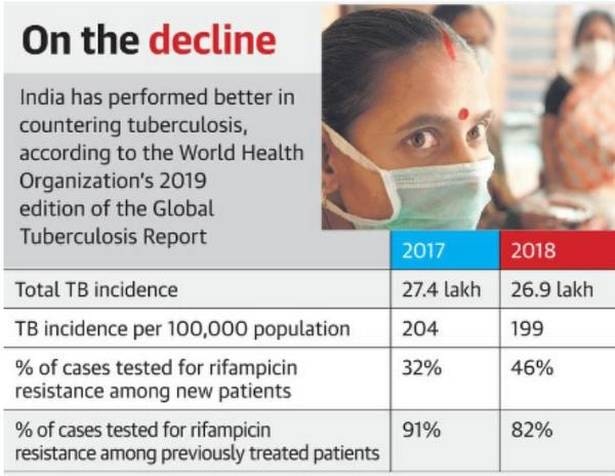Social Justice
Global Tuberculosis Report 2019: WHO
- 18 Oct 2019
- 5 min read
The World Health Organization (WHO) has recently released its 2019 edition of the Global Tuberculosis (TB) Report.
- The report provides a comprehensive and up-to-date assessment of the TB epidemic and progress in the response at global, regional and country levels for India.
- WHO has been publishing global TB report every year since 1997.
Key Findings
- TB remains the top infectious killer in the world claiming over 4,000 lives a day.
- Number of TB Cases:
- Geographically, most TB cases in 2018 were in the WHO regions of South-East Asia (44%), Africa (24%) and the Western Pacific (18%).
- High TB Burden Countries:
- Eight countries that accounted for two thirds of the global total include India (27%), China (9%) and Indonesia (8%).
- The above countries are also in WHO’s list of 30 high TB burden countries that accounted for 87% of the world’s cases in 2018.
- MultiDrug Resistant TB:
- In 2018, there were about half a million new cases of rifampicin-resistant TB (of which 78% had multidrug resistant TB).
- The three countries with the largest share of the global burden were India (27%), China (14%) and the Russian Federation (9%).
- TB Diagnosis:
- Globally, 7.0 million new cases of TB were notified in 2018 – an increase from 6.4 million in 2017.
- Most of the increase in global notifications of TB cases since 2013 is explained by trends in India and Indonesia, the two countries that rank first and third worldwide in terms of estimated incident cases per year.
- In India, notifications of new cases rose from 1.2 million to 2.0 million between 2013 and 2018 (+60%).
- Concerns:
- Despite increases in TB notifications, there is still a large gap between the number of new cases reported (7.0 million) and the estimated 10.0 million incident cases in 2018.
- This gap is due to a combination of underreporting of detected cases and underdiagnosis (i.e. people with TB do not access health care or are not diagnosed when they do).
- Ten countries accounted for about 80% of the gap, with India (25%), Nigeria (12%), Indonesia (10%) and the Philippines (8%) accounting for more than half of the total.
- TB Treatment Outcomes:
- The latest treatment outcome data for new cases of TB show a global treatment success rate of 85% in 2017, an increase from 81% in 2016. The improvement was mainly due to progress in India.
- Financing for TB Prevention:
- Funding for the provision of TB prevention, diagnostic and treatment services has doubled since 2006.
- In India, domestic funding quadrupled between 2016 and 2019.
- Suggestions:
- Annual financing for TB prevention and care and for TB research needs to approximately double.
- Access to TB care and preventive treatment needs to be expanded.
- Substantial costs faced by TB patients and their households should be mitigated.
- Multisectoral action on the broader determinants of the TB epidemic needs to be intensified.
- Intensified research and development is required to meet the Sustainable Development Goals (SDGs) and End TB Strategy targets set for 2030.
- The End TB Strategy milestones for 2020 and 2025 can only be achieved if TB diagnosis, treatment and prevention services are provided within the context of progress towards Universal Health Coverage (UHC).
- UHC means that everyone can obtain the health services they need without suffering financial hardship.
- SDG Target 3.8 is to achieve UHC by 2030.
WHO End TB Strategy
- The strategy aims to end the global TB epidemic, with targets to reduce TB deaths by 95% and to cut new cases by 90% between 2015 and 2035, and to ensure that no family is burdened with catastrophic expenses due to TB.
- It sets interim milestones for 2020, 2025, and 2030.




